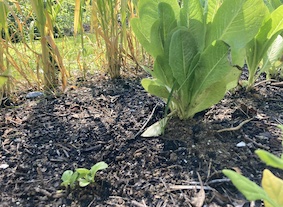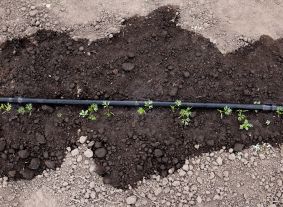Highly Recommended: Vermont Cranberry Beans
Views: 8910

Beans in pods, I’m not a big fan. Peas, yuck. Limas, horrible. And all those other beans, I’d rather not even try them. I think it has something to do with the way my mother would prepare them. That sounds horrible of me, doesn’t it? I know, I feel guilty for even writing this. But it’s true. Sorry, Mom. This spring I found a packet of Vermont Cranberry Bean seeds up for grabs on our community garden’s table. My garden neighbor had placed them there. He’s been growing them for years and years, and every spring he urges me to give them a try. This was the year to try them.
Growing Vermont Cranberry Beans
Growing is easy. I planted the Vermont Cranberry Beans around June, I believe, at 3-feet alternating on a 4 or 5 inch spacing. Even though the package said these seeds were packed for 2010, wouldn’t you know it, all of the seeds germinated.
I promptly put the package away and didn’t read any of the care instructions. I just watered them along with all the other plants in the garden. Fertilizer? Not any more than what the rest of the garden received, which I have to admit was woefully inadequate. But the Vermont Cranberry Beans kept growing and grew well.
By the beginning of August, the bean bushes were more than 2 feet tall and quite lush. They were flowering well, too. Beans were growing. A great sign. Green at first, Some of them began to lighten in color, becoming a mottled greenish and pinkish.
Harvesting
I consulted my garden neighbor about harvesting. When I planted these, I assumed dry bean meant I was to wait until all the pods were dry and I’d have dry beans to store for the winter. You can do it that way, he said, but he advised that for the best flavor you should harvest a bit before they dry. As the beans turn from green to pink, the last vestige of green that remains is found on the end tip of the bean. When that green is gone, that’s the time to harvest them.
He also said that in his experience about 70 percent of the beans are ready for harvest all at once, and the rest kind of coast in.
I was a bit delinquent for my first harvest. I had a gallon plastic bag’s worth of beans in all stages of dryness, from the green just leaving the tip to beans that had shriveling pods. And when I shelled the beans just gently pressing the tip of the pod until it pops open I found the loveliest red-and-pink mottled gems inside. Gorgeous.
Cooking with Vermont Cranberry Beans
My neighbor gave me a link to an Epicurious recipe for Vermont Cranberry Bean Salad. As simple as anything and delicious.
Boil the beans for 10-20 minutes, depending on their stage of dryness (I had to go the full 20 to cook the really dry beans), when done all mealiness in the bean will be gone. A little olive oil, fresh lemon juice, a generous sprinkling of chopped fresh parsley and salt and pepper to taste. Amazing.
Next year, Vermont Cranberry Beans are getting at least two rows and two different plantings in my garden. Give them a try yourself.
Meet Ellen Wells
When you’re raised on a farm, you can’t help but know a thing or two about gardening. Ellen Wells is our expert on edible gardening.…
Ellen's Recent Posts

Asparagus






